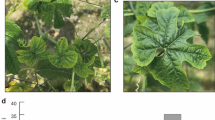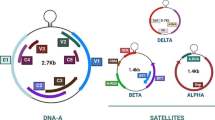Abstract
Betasatellites (DNA β) are circular ssDNA molecules that are associated with monopartite geminiviruses and exert a positive effect on the viral infection. Betasatellites encode one protein, named βC1, on the complementary strand; βC1 functions as a pathogenicity factor and RNA silencing suppressor. In this report, we describe the identification of another betasatellite-encoded protein, βVl, which also contributes to symptom development. The βVl open reading frame can be found on the viral strand of approximately 40% of reported betasatellite sequences, and is conserved in position and sequence. The presence of the βVl transcript was observed in plants infected with Tomato yellow leaf curl China virus (TYTCCNV) along with its associated betasatellite Tomato yellow leaf curl China betasatellite (TYTCCNB). Mutant viruses unable to produce βVl showed reduced virulence and decreased viral load. Ectopic expression of the TYTCCNB-PV1 gene in Nicotiana benthamiana plants from a PVX-based vector resulted in leaf mosaic and chlorosis. We further demonstrated that the βVl protein could elicit hypersensitive response (HR)-type cell death in N. benthamiana leaves. Our results uncover a novel betasatellite-encoded protein that contributes to the virus infection, and this discover gives us a more complete view of the plant-geminivirus interaction landscape.
Similar content being viewed by others
References
Briddon, R.W., Mansoor, S., Bedford, I.D., Pinner, M.S., Saunders, K., Stanley, J., Zafar, Y., Malik, K.A., and Markham, P.G. (2001). Identification of DNA components required for induction of cotton leaf curl disease. Virology 285, 234–243.
Cui, X., Tao, X., Xie, Y., Fauquet, C.M., and Zhou, X. (2004). A DNAβ associated with tomato yellow leaf curl China virus is required for symptom induction. J Virol 78, 13966–13974.
Cui, X., Li, G., Wang, D., Hu, D., and Zhou, X. (2005). A begomovirus DNAβ-encoded protein binds DNA., functions as a suppressor of RNA silencing, and targets the cell nucleus. J Virol 79, 10764–10775.
Ding, C., Qing, L., Li, Z., Liu, Y., Qian, Y., and Zhou, X. (2009). Genetic determinants of symptoms on viral DNA satellites. Appl Environ Microbiol 75, 5380–5389.
Fondong, V.N. (2013). Geminivirus protein structure and function. Mol Plant Pathol 14, 635–649.
Guo, W., Yang, X., Xie, Y., Cui, X., and Zhou, X. (2009). Tomato yellow leaf curl Thailand virus-[Y72] from Yunnan is a monopartite begomovirus associated with DNAβ. Virus Genes 38, 328–333.
Hanley-Bowdoin, L., Bejarano, E.R., Robertson, D., and Mansoor, S. (2013). Geminiviruses: masters at redirecting and reprogramming plant processes. Nat Rev Microbiol 11, 777–788.
Hanley-Bowdoin, L., Settlage, S.B., Orozco, B.M., Nagar, S., and Robertson, D. (1999). Geminiviruses: models for plant DNA replication, transcription, and cell cycle regulation. Crit Rev Plant Sci 18, 71–106.
Hu, T., Huang, C., He, Y., Castillo-Gonzalez, C., Gui, X., Wang, Y., Zhang, X., and Zhou, X. (2019). βC1 protein encoded in geminivirus satellite conceitedly targets MKK2 and MPK4 to counter host defense. PLoS Pathog 15, e1007728.
Li, F., Huang, C., Li, Z., and Zhou, X. (2014). Suppression of RNA silencing by a plant DNA virus satellite requires a host calmodulin-like protein to repress RDR6 expression. PLoS Pathog 10, e1003921.
Li, F., Zhao, N., Li, Z., Xu, X., Wang, Y., Yang, X., Liu, S.S., Wang, A., and Zhou, X. (2017). A calmodulin-related protein suppresses RNA silencing and promotes geminivirus infection by degrading SGS3 via the autophagy pathway in Nicotiana benthamiana. PLoS Pathog 13, e1006213.
Li, F., Yang, X., Bisaro, D.M., and Zhou, X. (2018). The βC1 protein of geminivirus-betasatellite complexes: a target and repressor of host defenses. Mol Plant 11, 1424–1426.
Li, F., Liu, W., and Zhou, X. (2019). Pivoting plant immunity from theory to the field. Sci China Life Sci 62, 1539–1542.
Laufs, J., Jupin, I., David, C., Schumacher, S., Heyraud-Nitschke, F., and Gronenborn, B. (1995). Geminivirus replication: genetic and biochemical characterization of Rep protein function, a review. Biochimie 77, 765–773.
Lazarowitz, S.G., and Beachy, R.N. (1999). Viral movement proteins as probes for intracellular and intercellular trafficking in plants. Plant Cell 11, 535–548.
Li, R., Weldegergis, B.T., Li, J., Jung, C., Qu, J., Sun, Y., Qian, H., Tee, C.S., van Loon, J.J.A., Dicke, M., et al. (2014). Virulence factors of geminivirus interact with MYC2 to subvert plant resistance and promote vector performance. Plant Cell 26, 4991–5008.
Li, Z., Xie, Y., and Zhou, X. (2005). Tobacco curly shoot virus DNAβ is not necessary for infection but intensifies symptoms in a host-dependent manner. Phytopathology 95, 902–908.
Mansoor, S., Briddon, R.W., Zafar, Y., and Stanley, J. (2003). Geminivirus disease complexes: an emerging threat. Trends Plant Sci 8, 128–134.
Patil, B.L., and Fauquet, CM. (2010). Differential interaction between Cassava mosaic geminiviruses and geminivirus satellites. J Gen Virol 91, 1871–1882.
Pooma, W., and Petty, L.T.D. (1996). Tomato golden mosaic virus open reading frame AL4 is genetically distinct from its C4 analogue in monopartite geminiviruses. J Gen Virol 77, 1947–1951.
Rojas, M.R., Jiang, H., Salati, R., Xoconostle-Cazares, B., Sudarshana, M.R., Lucas, W.J., and Gilbertson, R.L. (2001). Functional analysis of proteins involved in movement of the monopartite begomovirus, tomato yellow leaf curl virus. Virology 291, 110–125.
Saeed, M., Zafar, Y., Randies, J.W., and Rezaian, M.A. (2007). A monopartite begomovirus-associated DNA beta satellite substitutes for the DNA B of a bipartite begomovirus to permit systemic infection. J Gen Virol 88, 2881–2889.
Saunders, K., Bedford, I.D., Briddon, R.W., Markham, P.G., Wong, S.M., and Stanley, J. (2000). A unique virus complex causes Ageratum yellow vein disease. Proc Natl Acad Sci USA 97, 6890–6895.
Saunders, K., Norman, A., Gucciardo, S., and Stanley, J. (2004). The DNA p satellite component associated with ageratum yellow vein disease encodes an essential pathogenicity protein (βC1). Virology 324, 37–47.
Saunders, K., Briddon, R.W., and Stanley, J. (2008). Replication promiscuity of DNA-p satellites associated with monopartite begomoviruses; deletion mutagenesis of the Ageratum yellow vein virus DNA- satellite localizes sequences involved in replication. J General Virol 89, 3165–3172.
Scholthof, K.B.G., Adkins, S., Czosnek, H., Palukaitis, P., Jacquot, E., Hohn, T., Hohn, B., Saunders, K., Candresse, T., Ahlquist, P., et al. (2011). Top 10 plant viruses in molecular plant pathology. Mol Plant Pathol 12, 938–954.
Scotto-Lavino, E., Du, G., and Frohman, M.A. (2006). 5′ end cDNA amplification using classic RACE. Nat Protoc 1, 2555–2562.
Shen, Q., Hu, T., Bao, M., Cao, L., Zhang, H., Song, E., Xie, Q., and Zhou, X. (2016). Tobacco RING E3 ligase NtRFPl mediates ubiquitination and proteasomal degradation of a geminivirus-encoded βC1. Mol Plant 9, 911–925.
Singh, A.K., Chattopadhyay, B., and Chakraborty, S. (2012). Biology and interactions of two distinct monopartite begomoviruses and betasatellites associated with radish leaf curl disease in India. Virol J 9, 43.
Sunter, G., and Bisaro, D.M. (1991). Transactivation in a geminivirus: AL2 gene product is needed for coat protein expression. Virology 180, 416–419.
Sunter, G., and Bisaro, D.M. (1992). Transactivation of geminivirus AR1 and BR1 gene expression by the viral AL2 gene product occurs at the level of transcription. Plant Cell 4, 1321.
Varsani, A., Navas-Castillo, J., Moriones, E., Hernandez-Zepeda, C., Idris, A., Brown, J.K., Murilo Zerbini, F., and Martin, D.P. (2014). Establishment of three new genera in the family Geminiviridae: Becurtovirus, Eragrovirus and Turncurtovirus. Arch Virol 159, 2193–2203.
Varsani, A., Roumagnac, P., Fuchs, M., Navas-Castillo, J., Moriones, E., Idris, A., Briddon, R.W., Rivera-Bustamante, R., Murilo Zerbini, F., and Martin, D.P. (2017). Capulavirus and Grablovirus: two new genera in the family Geminiviridae. Arch Virol 162, 1819–1831.
Xiong, Q., Fan, S., Wu, J., and Zhou, X. (2007). Ageratum yellow vein China virus is a distinct begomovirus species associated with a DNAβ molecule. Phytopathology 97, 405–411.
Xu, X., Qian, Y., Wang, Y., Li, Z., and Zhou, X. (2019). Herons homologous to helper geminiviruses are essential for efficient replication of betasatellites. J Virol 93, e01532–18.
Yang, J.Y., Iwasaki, M., Machida, C., Machida, Y., Zhou, X., and Chua, N.H. (2008). βC1, the pathogenicity factor of TYLCCNV., interacts with AS1 to alter leaf development and suppress selective jasmonic acid responses. Genes Dev 22, 2564–2577.
Yang, X., Xie, Y., Raja, P., Li, S., Wolf, J.N., Shen, Q., Bisaro, D.M., and Zhou, X. (2011). Suppression of methylation-mediated transcriptional gene silencing by pCl-SAHH protein interaction during geminivirus- betasatellite infection. PLoS Pathog 7, e1002329.
Yang, X., Guo, W., Ma, X., An, Q., and Zhou, X. (2011). Molecular characterization of Tomato leaf curl China virus, infecting tomato plants in China, and functional analyses of its associated betasatellite. Appl Environ Microbiol 77, 3092–3101.
Yang, X., Guo, W., Li, F., Sunter, G., and Zhou, X. (2019). Geminivirus- associated betasatellites: exploiting chinks in the antiviral arsenal of plants. Trends Plant Sci 24, 519–529.
Yang, X., Zhou, H., and Zhou, X. (2019). Rock paper scissors: CRISPR/ Cas9-mediated interference with geminiviruses in plants. Sci China Life Sci 62, 1389–1391.
Zhang, T., Xu, X., Huang, C., Qian, Y., Li, Z., and Zhou, X. (2016). A novel DNA motif contributes to selective replication of a Geminivirus- associated betasatellite by a helper virus-encoded replication-related protein. J Virol 90, 2077–2089.
Zhou, X. (2013). Advances in understanding begomovirus satellites. Annu Rev Phytopathol 51, 357–381.
Zhou, X., Xie, Y., Tao, X., Zhang, Z., Li, Z., and Fauquet, C.M. (2003). Characterization of DNAβ associated with begomoviruses in China and evidence for co-evolution with their cognate viral DNA-A FN1. J Gen Virol 84, 237–247.
Acknowledgements
We thank Dr. Fangfang Li (Institute of Plant Protection, Chinese Academy of Agricultural Sciences) and Dr. Rosa Lozano-Duran (Shanghai Center for Plant Stress Biology, Chinese Academy of Sciences) for their critical reading of the manuscript and helpful comments. This work was supported by grants from the National Natural Science Foundation of China to Y.Q. W. (31972235) and to X.P.Z. (31720103914).
Author information
Authors and Affiliations
Corresponding authors
Ethics declarations
Compliance and ethics The author(s) declare that they have no conflict of interest.
Rights and permissions
About this article
Cite this article
Hu, T., Song, Y., Wang, Y. et al. Functional analysis of a novel βV1 gene identified in a geminivirus betasatellite. Sci. China Life Sci. 63, 688–696 (2020). https://doi.org/10.1007/s11427-020-1654-x
Received:
Accepted:
Published:
Issue Date:
DOI: https://doi.org/10.1007/s11427-020-1654-x




